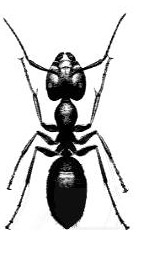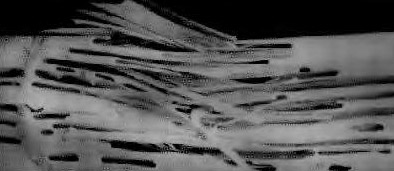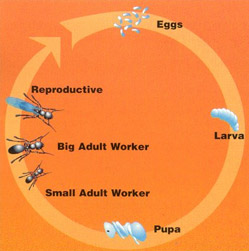
in Exterminating
since 1980
Current Topics
Summer 2025
» Not just a winter problem anymore. Mice! [more]
» LADY BUGS! (asian ladybird beetles) When spring arrives, these little pests will be emerging from their winter nap. Lady bugs... [more]
» STINK BUGS! What's with these things? [more]
» CARPENTER BEES! In recent years, we've seen a major influx of carpenter bees in the northeast. As the weather gets warmer, pest control companies will be fielding calls daily... [more]
Pest Tips and Facts

- carpenter ants do more damage than termites... and faster, too!
- insect damage is not covered by homeowner insurance.
CARPENTER ANTS

A: Carpenter ants, once established, are capable of doing a considerable amount of damage. Normally they don't do as much damage as termites, for example, because carpenter ants will be readily visible. If you have been ignoring their presence every spring because they normally 'go away' then you can expect to find serious damage at some point. Carpenter ants rarely just 'go away'. Their trailing habits simply change as their season progresses and temperature/food availability allow for exterior foraging.

Typical carpenter ant damage.
Note the smooth edges and the absence of sawdust or 'frass'.
A: There are several approaches to the elimination of carpenter ants. Frankly, most of them will involve engaging the services of a competent pest control company.
As a homeowner you may have some success if you are able to locate the colony or 'nest'. You will need to have an insecticide capable of fast knockdown readily available. As you begin to access the area of the colony, the ants will instinctively gather up as many pre-mature forms as possible and evacuate to a safer location. Insecticide dusts are recommended but few homeowners have access to that type of product or the equipment necessary to effectively deliver it to the colony site. Products containing permethrin or pyrethrins in an aerosol form are probably going to be your best bet.
Start by locating the colony. Try to locate the worker ant trail. Good places to look are: a.) The corners of the foundation near down spouts. b.) Concrete/brick stoops and the adjacent foundation. c.) Deck piers and wooden deck stair stringers and risers. d.) Phone/cable/electric lines connecting to the structure (especially if you have been using diazinon or a similar product around the foundation). Don't overlook clotheslines and wire pet runs. Ants will be moving in both directions. Follow the ones that are carrying foraged material. They are heading toward the colony. If you are very lucky, you will follow the ants right to the colony - actually seeing them enter the location. You may observe the above mentioned 'frass' being pushed out of a gallery 'window' or hear sounds similar to the rustling of wax paper. By accessing the available 'window' or by using a hole drilled into the gallery, inject the insecticide. A marked increase in the noise level and rapidly evacuating ants will be the evidence you are looking for. If, however, the ants you are following disappear under the siding, into the eaves or similarly inaccessible areas, then you are probably not going to have much success.
A: Again, there are several approaches that are commonly taken. Some are inadequate and others are over-kill. Spraying baseboards and foundations at monthly intervals will certainly keep ants out of sight and even appear to solve the problem. The likely result, however, will be a fairly large expense and a quick resurgence of activity immediately upon ending the treatment regimen. As treatments go...it's just not enough.
Drilling and injecting holes in all the window and door frames, between every stud on every level and generally all over the structure will probably eliminate the problem. But it will be very expensive, holes will be left open, plugs will fall out and the homeowner will often feel like he just got a major door ding in a new car!

Searching out the colony is, without question, the best way. If it is located, it can be thoroughly and quickly exterminated. But it too is costly due to the time involved and all too often the colony is in a place that just can't be found.
There is a happy medium that seems to work quite well, however. A treatment can be done that is so thorough as to leave an intolerable environment for ants to trail in and with material that so pollutes the trailing system and, ultimately, the colony that it can no longer survive in the structure. And since it is being done with less thought about finding the colony and with a more procedure oriented approach it will be far less costly.
Such treatments would include the use of insecticide dusts in such areas as sills, plumbing voids, chases, etc. High risk or suspicious areas may also be drilled and injected. Crack and crevice spraying of the baseboards would be a valuable part of this type of treatment as well.
Often, by the time a treatment such as this is completed, the operator has a pretty good idea where the colony is located and can take additional steps as indicated. Even if the colony is not located...the following factors would contribute to it's demise: a.) Primary workers would die as a result of exposure to the pesticides during trailing. b.) lack of incoming 'supplies' due to worker shortage would force more ants out of the colony to assume the foraging duties. c.) The colony would begin to suffer the effects of the shortages and the constant influx of insecticide residue into the gallery. d.) The process of worker attrition would ultimately render the colony inviable.
Finally, it should be noted that some in some cases, due to disrepair, roof or plumbing leaks or structural flaws that cause excessive wetness, this type of treatment may fail. In such cases finding the colony will become necessary.
· Keep gutters clean and free flowing. Use extensions on the down spouts to divert water downgrade and 2 or
3 feet from the foundation.
· Keep shrubs trimmed back and do not allow contact with the structure.
· Find out what are actually listed as foundation plants and stick with those.
· Store firewood 30 to 50 feet from the structure and only bring in what you need. Examine the cut ends of
the logs. If there is hollowing of the core, holes or suspicious looking damage, burn those first.
· Keep bathroom tile around the shower grouted and in good repair. Install bathroom vents and encourage
their use during showers.
· Repair plumbing leaks immediately.
· Make sure any weep holes in storm window frames do not get plugged up.
· Install window air conditioning units so that the proper pitch is maintained for drainage of condensation.
· Do not allow lawn irrigation systems to wet the structure or foundation.
· Apply a sealant to spaces between the siding and chimney.


